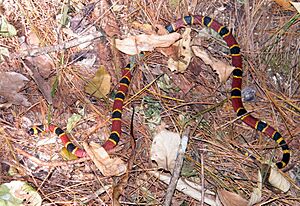Central American coral snake facts for kids
Quick facts for kids Central American coral snake |
|
|---|---|
 |
|
| Conservation status | |
| Scientific classification | |
| Genus: |
Micrurus
|
| Species: |
nigrocinctus
|
 |
|
| Synonyms | |
|
|
The Central American coral snake (scientific name: Micrurus nigrocinctus) is a type of highly venomous snake. It belongs to the family called Elapidae. This snake lives only in Latin America, from southern Mexico through Central America to northern Colombia. There are several different kinds, or subspecies, of this snake.
Contents
What are its common names?
People call Micrurus nigrocinctus by many names. In English, it's often known as the Central American coral snake. In Spanish, some common names include serpiente-coralillo centroamericana, coral centroamericana, coralillo, gargantilla, salviara, limlim, babaspul, and coral macho.
What does it look like?
The Central American coral snake can grow to be about 115 cm (45 in) long, which is over 3.5 feet! However, most are closer to 65 cm (26 in) (about 2 feet). It has smooth scales and a rounded head. Its eyes have round pupils.
This snake is famous for its bright colors. It can have two or three colors in its pattern. These colors are usually black, yellow, and red bands. The tip of its nose is black. On its head, there's often a yellow or red ring. Its body has wide red bands. These red bands are separated by much thinner yellow-black-yellow bands. The number of black bands on its body can be different for each snake, usually between 10 and 24. Its tail can have another 3 to 8 black bands.
Where does it live?
The Central American coral snake lives in a wide area. Its home stretches from southern Mexico, all the way through Central America (but not Belize), and into northwestern Colombia. It can also be found in the western Caribbean.
What kind of places does it like?
This snake prefers to live in certain types of forests. You can find it in lowland rain forests and lowland dry forests. It also lives in thorn forests and different kinds of montane (mountain) forests. It usually lives at elevations up to about 1,300 m (4,300 ft) (about 4,265 feet).
How does it behave?
The Central American coral snake mostly lives on the ground. It likes to hide in burrows, under piles of leaves, or beneath logs. Like most coral snakes, it is usually active at night. However, you might also see it moving around at dusk or dawn. Sometimes, it comes out after it rains.
This snake eats other animals. Its diet includes other snakes, small lizards, amphibians (like frogs), and even invertebrates (like worms or insects). While it's usually not aggressive, it will bite if it feels threatened or is bothered.
How does it reproduce?
The Central American coral snake is oviparous. This means that the female snake lays eggs.
What about its venom?
The Central American coral snake has very strong venom. Its venom contains a powerful neurotoxin. This neurotoxin affects the nervous system, which can cause problems with how muscles work. If a person is bitten, it's very important to get medical help right away.
Are there different types of this snake?
Yes, there are several recognized subspecies of the Central American coral snake. A subspecies is a group of animals within a species that has slight differences, often because they live in different areas. Some of these subspecies include:
- Micrurus nigrocinctus babaspul
- Micrurus nigrocinctus coibensis
- Micrurus nigrocinctus divaricatus
- Micrurus nigrocinctus mosquitensis (sometimes considered its own species)
- Micrurus nigrocinctus nigrocinctus
- Micrurus nigrocinctus ovandoensis
- Micrurus nigrocinctus zunilensis


